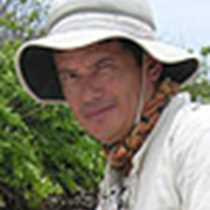Urbina Bay & Punta Moreno
Every single time I come to Urbina Bay, I am impressed by the incredible demonstration of the forces of nature and its instability. Here in 1954, 1.5 squared kilometers of marine reef along a front of 5km, was uplifted by as much as 5m. This event occurred very fast in a very short period of time, leaving much of the marine life stranded on the new seashore of Isabela.
After a wet landing, we started our visit walking along a rocky area, where we observed marine animals fossilized on the rocks. Just one sight was necessary to understand why it was impossible to try to recognize the area where was the sea floor previously; it is because vegetation has covered and deleted all the evidence of this place when it was undersea. Nowadays, salt bushes, muyuyu trees and mangroves replace algae. We saw brown pelicans, juvenile Galápagos hawks, great blue herons and the last witness of the uplifting: the huge piece of white coral. This magnificent formation is telling us that all this area belonged to the ocean before.
After walking for more than one hour and five hundred meters inland we reached the previous seashore and observed the old black beach and the round rocks, result of the sea erosion. Just behind a group of poison apple trees, two male iguanas fought for a special territory, moving their heads vertically (head bob). We enjoyed that scene for many minutes. One pushed and tried to bite the neck of the opponent and vice versa, but finally the two decided to leave all in peace. We finished the visit swimming off the beach and enjoying the waves like sea lions surfing.
In the afternoon we started the activities with a beautiful dinghy ride along Isabela’s coastline; red and white mangroves divided the shore in small bays creating beautiful tidal pools where sea turtles rested carefree. We disembarked at Punta Moreno. Located in between Sierra Negra and Cerro Azul volcanoes, this area is a natural barrier that prevents giant tortoises from each volcano having contact each other, and thanks to this natural protection this reptile was isolated for thousands of years preserving the purity of the species.
The landscape looked so barren and lifeless from the dinghy but when we landed we found life here; many brackish lagoons with flamingos, common gallinules, pintails and many different species of plants. Here we were witnesses of how Galápagos was millions of years ago, when the first reptiles arrived and how hard it was at the beginning.




